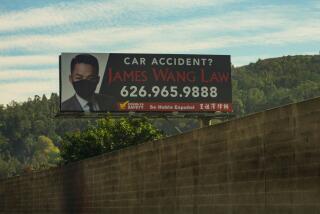Mixed Message Hurts Kids
- Share via
We all agree that minors should not use tobacco. And that more needs to be done to prevent them from using and having access to tobacco. --Philip Morris ad, May 17, 1996
Every day, children and adults throughout Los Angeles are confronted with billboard images that say smoking tobacco is exciting and drinking alcohol is fun and fulfilling.
These images reach children in ways that advertising in other media never does. While you can turn off the television or radio or skip a page in a magazine, there is no way to prevent young people from looking at billboards that are deliberately placed in their field of vision. This strategy works. Kids consume cigarettes and alcohol at a stunning and increasing rate.
On April 29, we asked the City Council to prohibit billboard advertising of tobacco and alcohol because we believe that children should not be subjected to this form of advertising. We expect the full City Council to take the first step toward enacting our proposal Tuesday. By taking this action, Los Angeles would be enacting an ordinance that builds on Baltimore’s ban, which the U.S. Supreme Court let stand in May after numerous legal challenges.
It is no longer a secret that tobacco and alcohol manufacturers target children in their advertising. Billboard advertising is no exception. Public health and medical studies show that children are the most susceptible to advertising. For example, one recent study concluded that teenagers are three times as likely as adults to respond to cigarette advertising. Even more alarming, it has been documented that children as young as 3 are able to recognize cigarette brands. Every day 3,000 children begin smoking.
The correlation between advertising and consumption of alcohol is equally stark. Public health studies show that the children who are most familiar with alcohol advertising are most likely to express positive beliefs about alcohol and, in turn, drink.
Advertising consisting of cartoon characters, rock stars and athletes has been recognized as increasing consumption of alcohol by young people. Nationwide, junior and high school students drink 1.1 billion cans of beer and 35% of wine coolers a year.
Underage consumption of tobacco has been documented to lead to a lifetime of smoking. Teenagers, who tend not to take into account the risks associated with their behavior, account for an astonishing 90% of new smokers.
The dire consequences of drinking by young people are more immediate. Alcohol-related motor vehicle accidents are the leading cause of death and disability among American teens. And drinking has been shown to be a factor in teen crime.
Another strategy of tobacco and alcohol manufacturers is to target minority communities. Research shows that a much greater percentage of billboards in minority communities advertise alcohol and tobacco products compared to other areas.
In the most recent inventory of billboards in the 9th Council District, which includes parts of downtown and south Los Angeles, more than two-thirds of the billboards advertised tobacco or alcohol. This targeted advertising and resulting consumption worsens the already significant health problems of minority communities.
Industry officials do not challenge the correlation between billboard advertising and consumption. Indeed, tobacco manufacturers already have recognized the link and have voluntarily agreed not to place such billboards within a certain distance from schools and playgrounds. But such a gesture is inadequate. Kids travel major thoroughfares lined with billboards throughout the city.
Critics of the proposed billboard ban claim that it will cost jobs. The hollowness of this argument was underscored by the 3M billboard company, which last year voluntarily agreed not to take tobacco advertising. In May, 3M was purchased by Outdoor Advertising for $1 billion and, according to Outdoor’s spokesman, the tobacco ban was no impediment to the purchase. As one market analyst commented, “the revenue lost from tobacco will be easy to replace.”
For good reason, it is illegal for kids to smoke or drink. Yet every day we permit our children to be exposed to billboard advertising that glamorizes smoking and drinking. No wonder underage consumption of alcohol and tobacco is on the rise.
We must stop sending mixed signals to our kids and ban billboards that advertise alcohol and tobacco. We must do no less.
More to Read
Sign up for Essential California
The most important California stories and recommendations in your inbox every morning.
You may occasionally receive promotional content from the Los Angeles Times.










